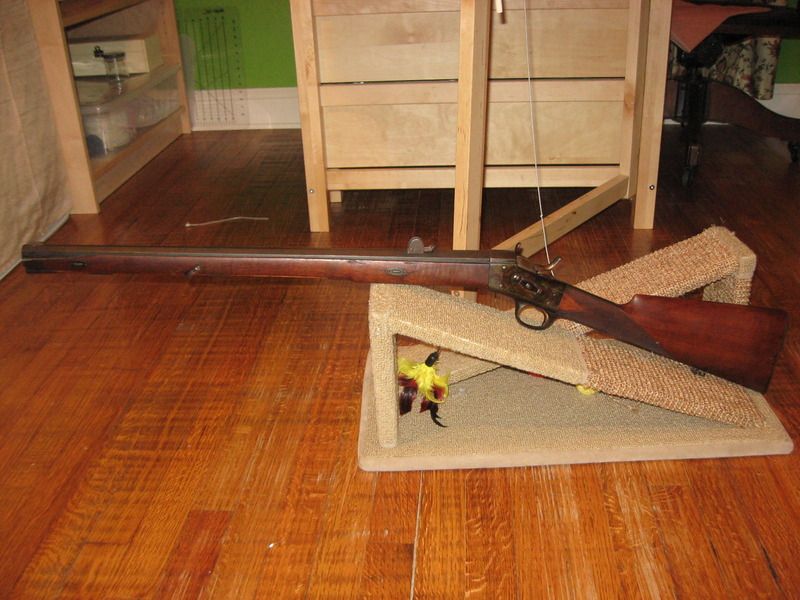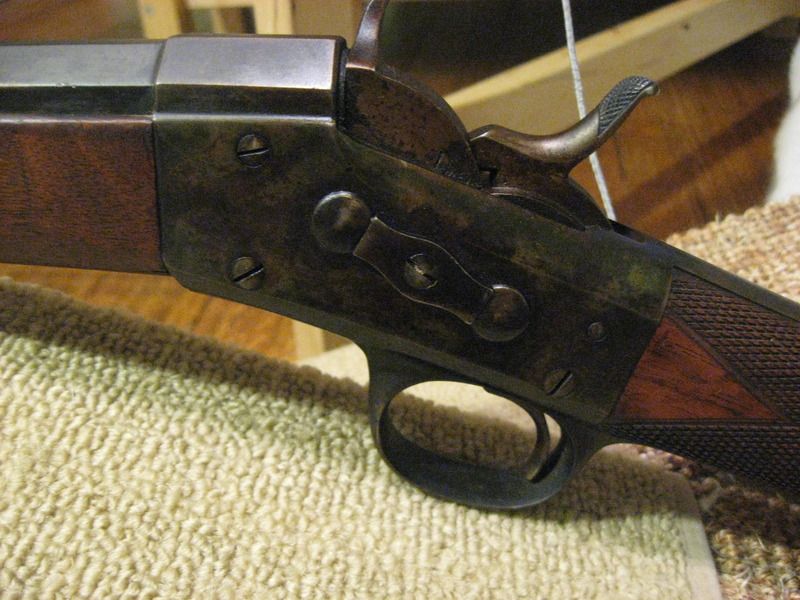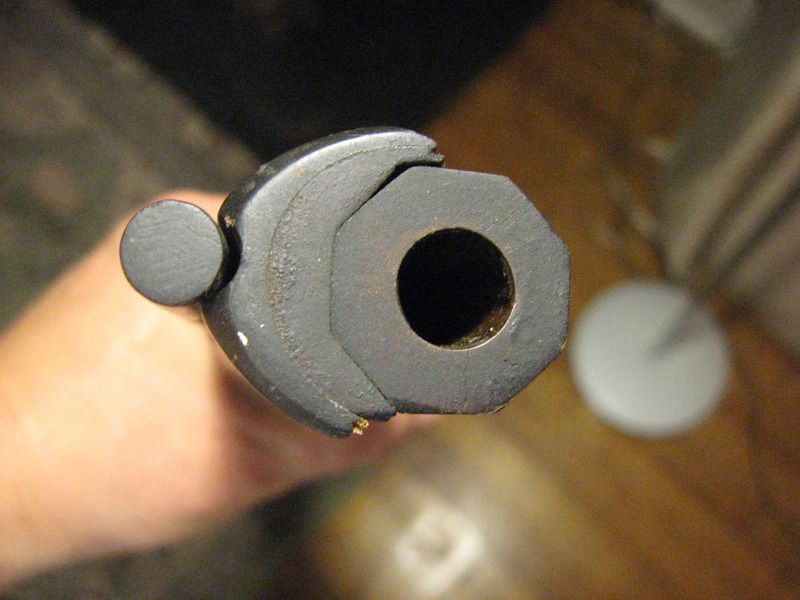| bigskybound |
| (.275 member) |
| 06/07/15 05:35 AM |
|
|
I recently picked up this interesting rolling block rifle. It is chambered in 10.25x69R Hunting Express. Is kind of beefy, weighing 7.5 lbs with a 25 5/8" octagonal barrel. Rifling is of the fast express kind. Most of my rolling blocks have a slow twist. It has a rear sight similar to ones on some Swiss rifles of the era I have seen.
It is my understanding that the 10.25x69R was developed for rifles for the Africa trade. I assume by that they mean for hunters of African game in the late 19th century. Seems to be a reasonably potent cartridge. What kinds of game would this rifle have been suited to?




| DarylS |
| (.700 member) |
| 06/07/15 05:59 AM |

|
|
|
Nice rifle - thanks for posting it.
I think that if the rifling is fast, it is for a long bullet, not an express bullet.
The English EXPRESS rifles have slower twists as the bullets were light weight for the caliber and were driven by rather large powder charges for the bore size, hence the term - "express" meaning high velocities.
Slow moving long bullets required faster twists, hence the faster twists in rifles designed for long bullets.
Typically, a .40 calibre rifle for a short bullet and fairly large powder charge would have a rifling twist in the 30" to 40" range, such as a 240gr. to a 260gr. bullet.
A .40 calibre rifle for a long bullet, would have a rifling twist in the 16" to 20" range for shooting bullets from about 360gr. to 400gr.
A .45 would run 30" to 48" in slow twists for short bullets, while a .45 would have from an 18" to 22" twist for longer bullets.
It is an interesting rifle & sight, with the weight of the barrel (thickness) telling me it was meant for a heavier bullet.
A 10.25X69mm ctg. would hold between 70 and 80gr. of black powder with a 360gr. to 400gr. bullet. It would be very similar to the .40/70 Sharps bottle necked ctg., I believe.
The ctg.would be quite suitable for any of the antelope and perhaps probably for the cats.
The various .40 calibre Sharps ctgs. were favoured by many hide & meat hunters for the shooting of bison on the American plains. Most used the 370gr. PP bullet.
| bigskybound |
| (.275 member) |
| 07/07/15 08:15 AM |
|
|
Thanks Daryl S. I never let my ignorance on a subject stay my hand at the keyboard! I guess I have always been under the misconception that the Express Rifling was faster. I just collect and shoot rolling blocks. I will have to try and determine the twist so I can find the right bullet. Would these longer bullets typically be paper patched? Not something I have done. I just fling big pieces of lead down range, with varying success.
| DarylS |
| (.700 member) |
| 08/07/15 02:29 AM |

|
|
|
Yes - bullets are lighter and faster in "Express" rifles, thus the rifling is slower.
In the bufflao hunting days, probably close to an equal split between grooved lubed and paper patched (commercial bullets mostly).
Perhaps the grooved lubricated were more prominent due to the prolific use of the surplus .50/70 rifles, both Sharps and Rem. RB's. Later on when made available, the Govt. did sell some .45/70's but the .50/70's were most prominent on the plains, in carbine rifle length.
This one used a groove lubricated bullet of 450gr. with 70gr. powder, as loaded in the military ctgs and supplied at the forts on the frontier. Many back then, called the .50/70 the 'big .50' - as compared to the smaller .45, .44 and .40's of the day.
Thus, these are the grounds for the continuing argument about what ctg. Billy Dixon actually used at Adobe Wall Indian battle - was it the original "The Big .50", aka .50/70, or the brand new barely released that year (maybe not even made it to Arizona yet), .50 2.5", known also as the .50/90 and also called "The Big .50" - however, it not known (by me) when it was 'coined' as such.
What is known, is that most .50/90 Sharps had 36" rate of twist, while the .50/70 Government rifles, both RB and Sharps had 42" twists. Both were deemed inaccurate (compared to more specialized .40 and .45 cal Sharps rifles) past about 300yards due to their slow twists.
To find the actual twist, a rod is used. Enter the rod at the chamber with a tight patch on a jag, stopping just a bit into the rifling. Make a mark on the rod, TDC at the chamber mouth, even with the breech-end of the barrel.
Make a mark on the rod at 6 o'clock on the rod (bottom of the rod), or put a piece of masking tape on the rod with a mark, same location. Push the patch into the bore and when your mark comes around, up to 12 o'clock (straight up, put another mark on the rod at the breech mouth, even with the end of the barrel.
Withdraw the rod and measure between the marks X 2 = rifling twist rate. This is the best method for shorter barrels if the rod will not rotate a complete 360 degrees within it he length of the barrel.
| Ash |
| (.400 member) |
| 08/07/15 05:10 PM |
|
|
Thats a gorgeous rifle! Is that CCH i can see?
| bigskybound |
| (.275 member) |
| 12/07/15 07:42 AM |
|
|
Quote:
Thats a gorgeous rifle! Is that CCH i can see?
Yes, under a dark film of tobacco smoke residue. I need to take the whole gun apart and clean metal and wood. I suspect the gun will be beautiful under the grime. There is a sliver of wood and piece of horn tip missing from left forestock. Might be worth the stock work.